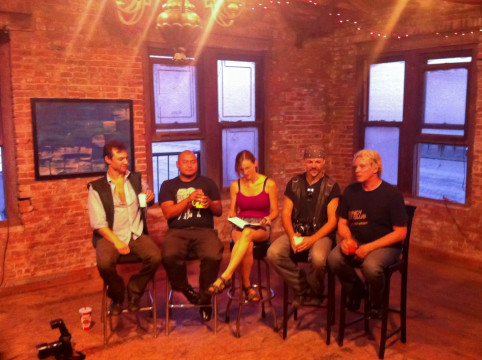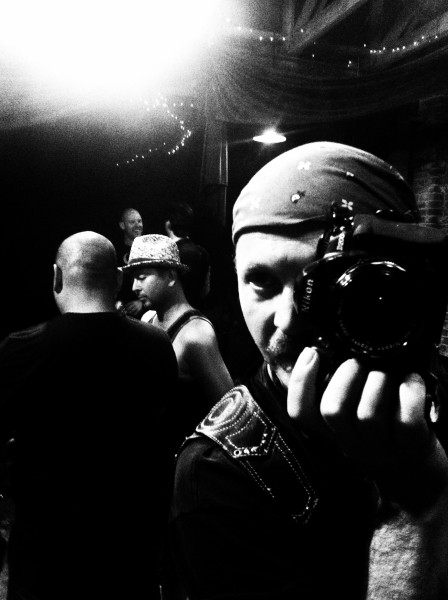A group of super-talented LA photographers got together in a downtown loft the other night to talk about taking pictures at Burning Man, and there was a ton of helpful information you want to know about, whether you're planning to bring a high-end DSLR, a disposable camera from the supermarket, or anything in between.
Here's who was there and where to see their work. Take a look. These folks are seriously good:
* Ryan Jesena - http://tinyurl.com/6k8epez
* Curious Josh - http://tinyurl.com/66mdqt3
* Steve Payne - http://www.paynie.net/
* Liana Bandžiulytė - http://tinyurl.com/5s8ucmx
* Kevin Rolly - http://www.kevissimo.com
So what they have to say about photographing on the playa is going to be worth your while. And we'll get to some of their tips in a minute, but there's some fine print that should come first. Lots has been written already about the rights and responsibilities of photographers on the playa, and we don't have to go over it all again. But what a lot of it boils down to is:

Don't be that guy (or girl).
Don't be that guy with the long lens snapping pics of people you don't know who don't have any clothes on.
Don't be that guy who posts compromising pictures of people he doesn't know and whose permission he doesn't have on Facebook and Flickr. As panelist Steve (Paynie) Payne said, there is powerful face-recognition technology built in to Facebook, and maybe that schoolteacher having a good time in the desert doesn't need her picture showing on her students' streams.
In the end, you want to be the the face of photography when you are out there. Be nice. Ask permission (before or after you take the picture). If someone objects, delete the picture for them. "Own your shit," as Kevissimo put it. "Don't be creepy. … Examine your intent every time you take a picture. What am I doing this for? … Are you being predatory with your camera? … Be acting in consciousness out there."
Or consider Paynie's solution to the problem of "sensitive" photos: He doesn't take them. He doesn't take pictures of naked people. Period. And yes, you can do it, too. There are LOTS of things to photograph besides women with bare breasts.
Of course, if you intend to do anything more with your photos than share them with family and friends, you're going to need permission from Burning Man. You'll also need to register your camera with Media Mecca. (They are really nice people, and you'll meet lots of other nice photogs there, too.)
There's more to find out about, and you can read the rules on the Burning Man site. But for now, let's talk about getting good shots and what you can do to take care of your camera.
You should realize right from the get-go that it's likely your camera is going to take a beating in the desert. The dust on the playa is infinitesimally small. It's going to get inside even the best weathersealed camera body. Even if you're staying in an RV, there's going to be dust everywhere. It's just the nature of the beast. But there are steps you can take to minimize the damage. "I'm no harder on my camera than I am on myself," Kevissimo said. But Kevissimo is realllly hard on himself, and his cameras, so you may not want to look at him as your role model. But he gets really great pictures, and you may want to damn the torpedoes and ride bareback, too.
At the other end of the spectrum, Curious Josh is an expert at protecting his camera. He's used the same one three years running, and it still looks brand new. He puts it in a ziplock bag, then cuts holes for the important button functions and seals them with heavy-duty electrical tape. He keeps his LCD screen encased in the kind of plastic hood you can buy at camera stores. He uses one lens, and he never takes it off the camera. (If you take off your lens, no matter where you are, dust is going to get into the innards.) He also says the best protection comes from underwater housings, and you can try that too, if you can pay the freight for one.
If the worst happens and something DOES go wrong with your camera, don't despair. Ryan's DSLR shut down the first day last year, and he "did what photographers do: adjust." He used his cameraphone for the rest of the week, and he took absolutely stunning photographs. Consider getting a couple of disposable cameras, or buying a broke-ass point-and-shoot off Craigslist for backup in case disaster strikes.
If you're buying a camera to take with you, consider buying a warranty, too. We won't get into brand names here, but there are some stores and chains that have liberal return policies. Three years and nine months after he bought his camera, Paynie brought his battered brick back to the box store where he bought it, and they took it back without a blink. His camera model had been discontinued, so they gave him full credit for it, and he bought a better one. Not bad.
Let's say you just took a fabulous photo and you want to be able to get in touch with the person or people in the picture when you get back to the default world. How are you going to match up the image with the contact information a couple of weeks later? Simple. Write down their information and take a picture of it. Then it'll be right there on your files, right next to the person's picture. Don't have a notebook? Write it in the dust, and snap a picture of it. Simple, no?
Don't think you have to get all the "big" shots out there. There are going to be lots of stunning pics of the Man and the Temple and all the great artwork. What there won't be are amazing photos of you and your friends having an amazing time. Kevissimo mostly skips the iconic imagery now. "For me, that kind of shooting is isolating," he said. So he takes photos of his campmates as they are right here, right now, and will never be again.
Consider not bringing a camera at all. Ryan Jesena, a photography professional, had been to the playa for five years before he brought his camera. Now he makes some of the best pictures there, and he looks at his work as his gift to the Burner community.
If you bring a serious camera to the desert, get it cleaned IMMEDIATELY when you get back. And before you get it to the shop, put it in a ziplock back with a bag of desiccant. The dust is going to get inside the camera, and when you get off the playa and back into your normal climate, that dust is going to attract moisture, and moisture is going to wreck the camera's electronics. The danger is particularly acute for people from high-humidity places like the Bay Area.
Tag your camera. Put your name on it, and where you're camping. "It might be the only place in the world where you can lose a camera and it will find its way back to you," Paynie said. And it's a GREAT idea to have your information on your memory cards, too. Write down your name and maybe a stirring plea about how important your camera is to you, and take a picture of it. Then leave that picture on all your memory cards. If someone finds your camera and takes a look at the pictures, they'll see you and your smiling face and how to get in touch with you.
Turn your flash off. It's just not going to work. Most times all you'll get are crappy, blown-out pictures with what looks like blowing snow in the air. (The dust is always in the air, and the flash will light it up. You won't like it.)
Ryan encourages you to "examine as many angles as you can think of for every shot you take. … Every shot is an opportunity to push the boundaries of what you do."
And finally, think of what you're doing as a gift. Liana pointed out that there's no way that everyone can see everything that's out there. No way. She's a documentary photographer, and she views what she does as a service.
Have fun, and see you out there.



No comments:
Post a Comment